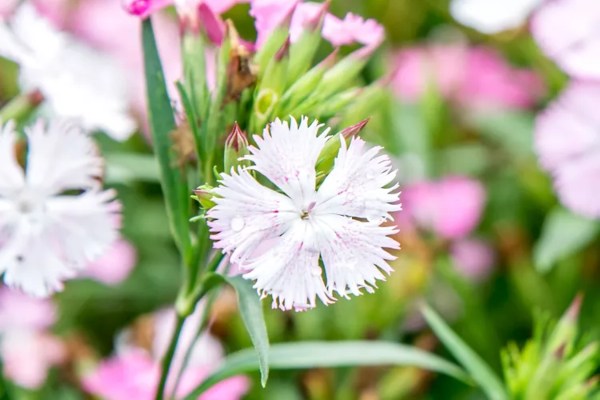Dianthus plants can have annual, perennial, or biennial varieties and they are also nicknamed “pinks” due to the pinked or fringed edges of the dainty flower petals. Perennial dianthus returns every year and is super easy to grow. They bloom best when they receive enough sunlight but hate mid-summer’s extreme heat. Their soil preference is slightly alkaline and will go dormant with frost or temperatures above 85 degrees Fahrenheit. These plants are toxic to pets.
Plant Attributes
- Common Name: Dianthus flowers, pinks, garden pinks, cheddar pinks, clove pinks, gillyflower
- Botanical Name: D. plumarius, D. superbus, D. deltoides
- Family: Caryophyllaceae
- Plant Type: Perennial
- Mature Size: 6–36 in. tall, 6–24 in. wide
- Sun Exposure: Full sun
- Soil Type: Moist but well-drained
- Bloom Time: Spring, summer, fall
- Flower Color: White, lilac, red, pink
- Hardiness Zone: 3-9, USA
- Native Areas: Europe, Asia, Africa
- Toxicity: Toxic to pets
Perennial Dianthus Care
Here are some of the main care requirements for growing a perennial dianthus plant:
- Requires full sun, with at least six hours of light.
- Water once a week with at least an inch of water.
- It prefers a slightly alkaline soil that is well-draining.
- Thrives from 40 F to 85 F; otherwise, the plant will enter dormancy.
- Plant in compost-enriched soil; doesn’t need fertilizer.
Light
Full sun is necessary for thriving plants. Therefore, choose a location that gets at least six hours of proper sunlight daily. If they don’t get enough sunlight, you can see a reduction in their blooms and flower vibrancy.
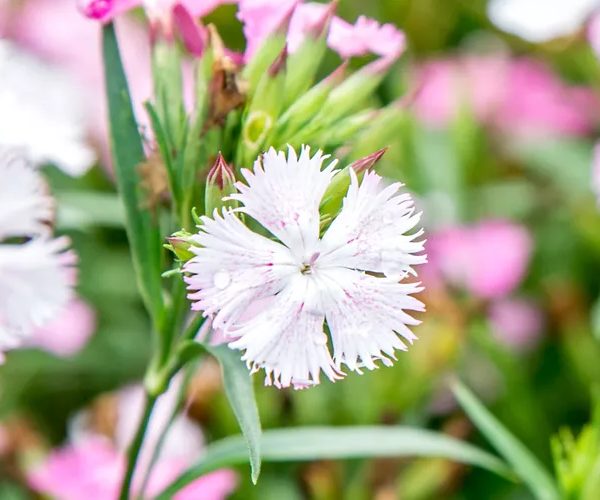
Also, Read Low maintenance Garden border Ideas || Best plants for garden edges
Soil
The soil for the dianthus plant should be well-draining otherwise there can be a root rot problem. Choose containers or raised beds for your plants if the garden soil is heavy clay.
This plant prefers a neutral to a bit alkaline soil pH. If the soil is below 7.0, you can maintain its acidity by applying dolomitic limestone. Alternatively, fireplace ashes can also increase soil alkalinity. You can also use mulch to control the weeds. But be careful not to let the mulch crowd around the crowns of dianthus to prevent rot.
Water
You have to water dianthus flowers weekly. The watering must be 1 inch of water per week. But do not overlog the soil.
Temperature and Humidity
While Dianthus can tolerate light frost, they despise deep freeze. If the temperatures drop below 40 degrees Fahrenheit, cover your plants with a frost blanket for their protection. The flowers can also go dormant in long hot summers where temperatures go above 85 degrees Fahrenheit.
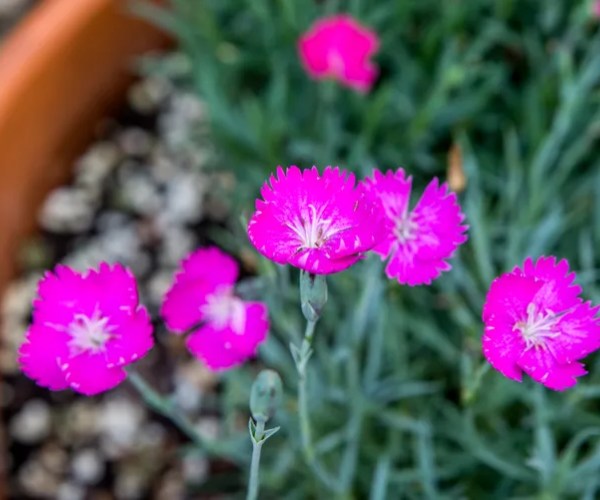
Fertilizer
Since these plants are light feeders, they do not need that much of fertilizers. A shovelful of compost mixed into the soil once a year will do the job for the plant’s nourishment.
Types of perennial dianthus
Most of the perennial dianthus varieties originated from Europe, Asia, and Africa. They have charming, colorful, and fragrant flowers. Some of the most common types are:
- D. deltoides ‘Arctic Fire’: This varietal features a contrasting “eye” (center) more commonly found in biennial varieties.
- D. gratianopolitanus ‘Firewitch‘: This hot pink varietal has been in cultivation since 1957.
- D. ‘First Love’: This varietal may have white and pink blossoms at the same time and often boasts repeat blooms.
- D. plumeria ‘Rose de Mai’: This fragrant heirloom varietal with lilac flowers, is often used in perfumes.
Pruning perennial dianthus
If you properly prune your dianthus, chances are you may increase the chance of repeat blooming and that will also keep the plant tidy and healthy throughout the year. Once spent, the flowers should be deadheaded, especially for varietals that are popular for their repeat blooms.
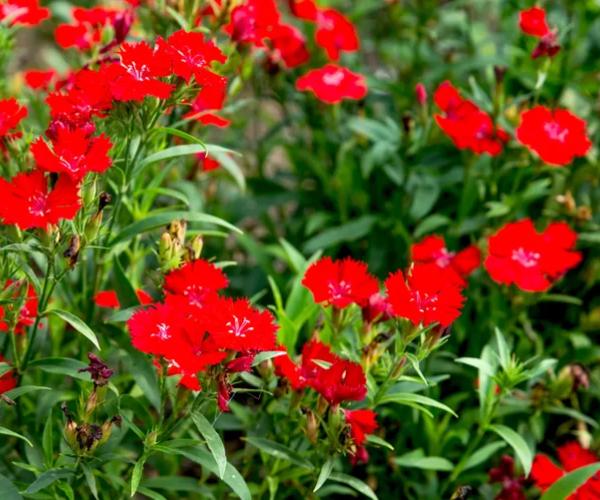
If there are any damaged stems or leaves, remove them ASAP. When fall arrives, prune back the plant until only 1 to 2 inches of stem is seen above the soil. The plant will go dormant for the season and will regrow the following spring.
How to propagate perennial dianthus
Dianthus are more readily started from seed but you can also propagate them using stem cuttings, ensuring that they have the same characteristics as their parent plant. If you want to propagate by cuttings, there are a few steps:
- Firstly, take a 2- to 3-inch cutting from an established mother plant that has bloomed for at least a full season. Take the cuttings in June or July after the bloom is done for the season.
- Mix potting soil with vermiculite in a small pot. Ensure that the mixture is not damp or soggy.
- Dip the cut end of the cutting in a rooting hormone. (This is optional)
- Plant the cutting into the potting soil. It should root within a month.
- Once a new leaf growth occurs, you can transplant the cutting.
How to grow perennial dianthus from seed
You can easily grow dianthus plants from seed. However, we can not guarantee that the resulting plants will be the exact copy of the parent plant. These plants grow fast and it’s best to start in the spring after all risk of frost is gone. Seedlings can develop in almost eight days. The plant will develop in under three months.
- Sow seeds in a seed tray indoors eight weeks before the final frost in your area. Place the seed on the soil surface and cover it gently with soil. The seeds need light to germinate.
- Keep the seed tray somewhere warm and sunny until the seedlings germinate. This should happen in approximately eight to ten days.
- It is necessary to grow the seedlings indoors until they reach 4 inches tall. Once the risk of frost has passed, you can plant them outdoors.
Common Pests and Plant Diseases
One of Dianthus’s biggest problems is vascular wilt. You can identify it by dull green stems that droop and eventually dry out. Wilt is basically a fungus that destroys the whole plant. Treatment can be difficult as fungicides are not helpful. Therefore it is necessary to take preventive measures and it is necessary to frequently rotate your plantings and avoid planting them in diseased soil.
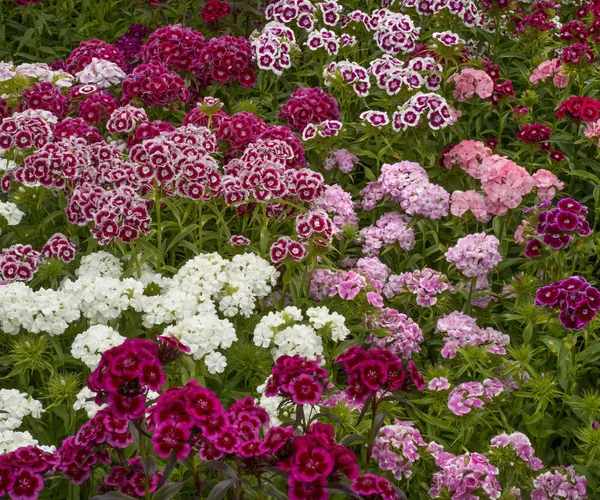
Also, dianthus plants may be susceptible to plant pests like spider mites and aphids. For treatment, you can apply insecticidal soap or neem oil until the infestation is gone. While dianthus plants are deer-resistant, that doesn’t go the same for rabbits.
How to get perennial dianthus to bloom
Bloom months
Dianthus blooms happen in May through most of the summer and it usually slows down during extreme heat. Most prolific blooms happen in the late spring and some possible reblooms happen in the fall after the high temperatures go down.
What do dianthus flowers look and smell like?
Dianthus blooms may be single or double but they all have the same jagged-edged petals. These flowers have five parts and color varies in pink, pink-purple, or white. Their smell is a sweet, spicy scent with cinnamon and clove undertones.
The foliage of this plant is bluish-grey and showy when the plants don’t bloom. The narrow, grass-like foliage may show a mounded, erect shape, or trailing habit.
How to encourage more blooms
Dianthus plants are very easy to care for and do not have much trouble blooming. To encourage more blooms, you can do these things:
- Give enough light: Dianthus plants should be kept in a place with at least six hours of bright sunlight daily. Too little light can affect the frequency and vibrancy of the blooms and overall performance.
- Give more water: Proper watering is essential for dianthus plants’ overall health and blooming. Frequent weekly watering helps in making the soil moist and it doesn’t dry out. Mulching over the soil around the plant’s roots to lock in moisture and prevent evaporation.
- Deadhead: Frequently deadheading the spent blooms lets the plant have a second bloom later in summer or early in the fall by producing more buds and foliage rather than putting energy into turning the spent flowers into seeds.
Common Problems With Perennial Dianthus
Here are some problems that this plant may face:
Yellowing or Failing to Thrive
If your dianthus starts yellowing or dying, this dormancy behavior is a natural phenomenon during periods of high heat and when temperatures start to drop. Overwatering can also be the cause of the leaves yellowing. Ensure the soil is moist but not soggy.
Brown, Crispy Leaves
Lack of water can develop brown, crispy, or curled leaves. The leaves and stems may also start to become floppy.
FAQs
Q: What planting locations work well with dianthus?
A: Dianthus plants’ mounding shape and long blooming time make them welcome additions to any container garden. In garden beds, place dianthus at the front and along borders so you can appreciate their pleasant clove fragrance. You can also add dianthus plants to a butterfly and hummingbird garden, as the flowers attract both with their nectar. Dianthus also works well in an alpine or rock garden, where they thrive in the fast-draining soil.
Q: Will dianthus spread on its own?
A: Dianthus can spread about a foot from the plant by self-seeding.
Q: Are dianthus plants easy to care for?
A: As long as they’re given the proper growing environment, dianthus plants are easy to care for and perfect for beginner gardeners.
Q: Can dianthus plants grow indoors?
A: Dianthus plants can be started indoors when growing from seed or being propagated, but most dianthus plants are typically grown outdoors long-term.
Q: What plants are similar to dianthus?
A: If you’re looking for blooms similar to dianthus that can also be used as groundcovers, look to plants like snow in summer or creeping phlox, both of which are pet-friendly.
Also, Read A Complete Guide to Grow and Care for Hens and Chicks Plants
